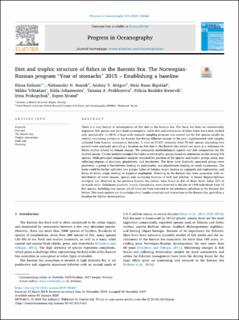Diet and trophic structure of fishes in the Barents Sea: the Norwegian-Russian program “Year of stomachs” 2015 - establishing a baseline
Eriksen, Elena; Benzik, Aleksander N.; Dolgov, Andrey V.; Skjoldal, Hein Rune; Vihtakari, Mikko Juhani; Johannesen, Edda; Prokhorova, Tatiana; Keulder-Stenevik, Felicia Juanita; Prokopchuk, Irina; Strand, Espen
Peer reviewed, Journal article
Published version
Permanent lenke
https://hdl.handle.net/11250/2684272Utgivelsesdato
2020Metadata
Vis full innførselSamlinger
- Articles [3040]
- Publikasjoner fra CRIStin [3105]
Originalversjon
10.1016/j.pocean.2019.102262Sammendrag
There is a long history of investigations of fish diet in the Barents Sea. The focus has been on commercially important fish species and their food consumption, while diet and interactions of other fishes have been studied only sporadically. In 2015, a large-scale stomach sampling program was carried out for fish species caught on routine monitoring surveys in the Barents Sea during different seasons of the year, supplemented with samples collected from Russian commercial fisheries. A total of 27,657 stomachs from 70 fish species (including two genera) were analysed, providing a baseline on fish diet in the Barents Sea which can serve as a reference for future studies related to climate change. We summarize methodological aspects and diet composition for the studied species. Cluster analysis grouped the fishes in nine trophic groups based on similarities in diet among fish species, while principal component analyses revealed the position of the species and trophic groups along axes reflecting degrees of piscivory, planktivory, and benthivory. The three most distinctly separated groups were piscivores, a group of benthivores feeding on polychaetes, and planktivores feeding on small crustaceans. The latter could be further split into two groups: fishes of Atlantic origin feeding on copepods and euphausiids, and fishes of Arctic origin feeding on hyperiid amphipods. Warming in the Barents Sea were associated with redistribution of water masses, species and increasing biomass of krill and jellyfish. A boreal Meganyctiphanes norvegica, not observed in the northern Barents Sea before, were found in diet of three Arctic fishes (2% of stomachs only). Gelatinous plankton, mainly Ctenophora, were observed in the diet of 1430 individuals from 15 fish species, including two species which have not been reported to eat gelatinous plankton in the Barents Sea before. This work updates our knowledge about trophic structure and interactions in the Barents Sea, providing a baseline for further investigations.
